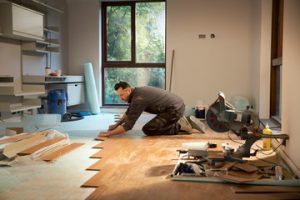Flooring is an important part of a home, but it has limited its lifespan. Whether from normal wear and tear or damage, knowing when it’s time for an update is key.
Visible wear like scratches, dents, or fading is the first sign it’s time for new floors. However, there are more subtle signs that should also be monitored.

Age
If your floors are showing a lot of wear, it may be time to think about replacing them. A few scratches and stains are normal, but deeper scratches can expose the subfloor and create structural damage. Cracks and rot are also issues that can occur when your flooring is too old.
Another sign of your floor’s age is if you notice that the colour has faded. Weathered grey wood is still a popular choice, but may be starting to look dated. If you’re looking for a fresh new look, consider upgrading to warmer, richer tones.
A full replacement is also a great idea if you’re planning to sell your home in the future. Sleek, new floors can add value to your home and make it stand out against the competition.
If you’re not planning to sell anytime soon, but you feel like it’s time for a change, a partial renovation is a good way to refresh your floor. You can install carpet in high-traffic areas and hardwood in the living room to give your home a fresh new look that will please buyers. This will help you sell your home faster and get the most out of your investment.
Damage
A few scratches and scuffs on hardwood floors are normal, but if you notice that the damage has gotten out of hand, it may be time to replace your flooring. Likewise, if you have carpet that is a breeding ground for mildew and mold spores, replacing it with something that doesn’t trap smells can help keep your family healthy and happy.
Cracks and gaps in your floor are another sign that you need to consider replacement. These aren’t just unsightly—they can also present a hazard, especially if they’re in high-traffic areas.
Water damage is another huge issue that can affect the long-term durability of your floors. While it’s possible to repair some kinds of water damage (like gray water, which is contaminated from dishwashers and toilets or from clean rainwater), others require full replacement. For example, black water—which can contain disease-carrying bacteria from sewage, flooding rivers or streams—requires professional replacement to prevent serious health problems.
If your floors feel squishy or move when you walk on them, that’s a sign of moisture damage. Moisture not only looks unattractive—it can cause buckling and warping in some materials, and it can lead to mould and mildew that will ruin your floors, harm your family’s health, and increase your energy bills. Similarly, if you find that your carpets have become less dense over time and no longer hold dust, pet hair, or other debris like they used to, it’s probably a good idea to replace them with something more durable.
Water Damage
If your flooring shows signs of water damage, it may be cleaned and restored. But if the damage is severe, it is better to replace the flooring. A water-damaged floor not only looks unattractive, but it can also lead to mold and mildew, which can be harmful to your health and cause structural problems for the home.
Whether it’s caused by a flood or an overflowing toilet, you need to act fast to dry out the floors. If left for too long, the water can penetrate the subflooring and lead to rot, mould, mildew, and other expensive and extensive damage to the building structure.
A professional disaster restoration expert can help you determine the extent of the damage and provide effective repair solutions. They can use fans and dehumidifiers to speed up the drying process. They can also test the moisture content of the subflooring and flooring to see if it is possible to restore or replace them.
The type of water that causes flooding and floor damage can be classified as gray or black water. Clean water from dishwashers and washing machines is considered gray water, but black water is contaminated with sewage, chemicals, and other waste and requires professional replacement assistance. Even if you are using “waterproof” or laminate flooring, it is important to take the necessary steps to prevent water damage and keep your home safe.
Aesthetics
If your floors are no longer a good fit for the rest of your decor, it might be time to replace them. If you have weathered grey wood-look floors, for example, they might no longer look as fresh as they once did. Investing in new flooring could help you bring your space up to date with more current warm tones like cognac, chocolate, green, plum, and rust.
Philosophers have devoted much attention to the idea of aesthetic experience. Some have used it to defend deep engagement with the arts (Shelley 1832 [2003]), to give a substantive definition of art (Hume 1790 [1960]), or to elevate’real’ art above other cultural media (Kant 1684 [1969]).
But many have objected to these stances as either too narrow or too broad in their purview. One common objection is to formalism: the view that what makes an experience “aesthetic” is its focus on form, independently of whether it has a functional role or an apprehension of the divine. But if this is the case, it’s not clear why any experience would be enjoyable and valuable in its own right, or why it might be privileged above other experiences. For this reason, some philosophers have opted for the more moderate view that what makes an experience “aesthetic” involves a kind of pleasure that is self-contained in its terms.